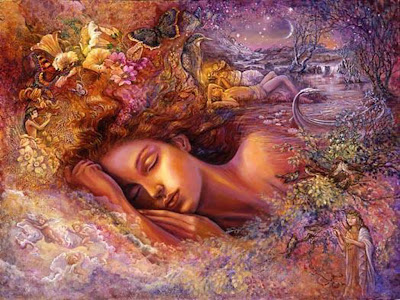Throughout human history, dreams have been the subject of science and pseudoscience alike. (Last year’s announcement that scientists in Kyoto could partially “read dreams” sounded like BS, but it checks out.) In today’s crazy online world where you can’t always believe your eyes, we hope you’ll sleep better knowing that the following facts are the real deal.
1. DREAM LOGIC IS NEUROLOGICALLY LOGICAL
Your brain’s activity looks very different when you’re asleep, which sheds some light on the nature of dreams. For starters, your primary visual cortex is out of commission during sleep (because your eyes are closed), but your secondary visual cortex (which normally interprets outside visual stimuli) is still going at it, trying to make sense of the images the rest of your brain is conjuring up.
Your limbic system (hippocampus and fornix––the wormy tangle all up in the middle of your brain) is the primary control center for your emotions, and it becomes especially active during your dreams. This explains why dreams are so emotionally charged, and often deal with feelings of imminent danger. Meanwhile, the dorsolateral prefrontal cortex, which controls logic and rationality, is practically dormant, which explains why you can dream yourself marrying Hugh Griffith in an cosmonaut suit and be like, “Can we have the guests throw sand instead of Cracker Jacks, Hughie? Birds tend to choke on the prizes.”
2. YOU ALSO DREAM DURING “NON-REM” SLEEP
By now everyone knows that we categorize human sleep in five stages: some deep stages with boring number-names, and REM, famously responsible for dream time. Au contraire! More recent research indicates that dreaming also occurs during non-REM sleep (slyly abbreviated as NREM). REM sleep is the stage closest to waking, though, so you’re more likely to remember REM dreams than those in NREM.
Since each sleep stage represents different brain activity, different stages will result in different types of dreams. During REM sleep, for instance, people typically report interacting with two to three characters outside of themselves––usually people they know in waking life––while NREM may host more characters, more of whom are strangers. At the same time, the dreamer more often initiates socially aggressive interactions in REM sleep, while NREM hosts friendlier social initiations. Makes it hard not to read a “don’t you dare wake me up” subtext into those REM dreams...
3. PAIN CAN SHOW UP IN DREAMS
While it’s never been proven that dreams themselves can produce pain, a few studies have suggested that real-world pain can incorporate into dreams. In one study, a lab-induced “pins and needles” sensation manifested as a problematic shoe-fitting in the subject’s dream, while more intense pain (like that experienced by healing burn victims in a 2002 study) can produce nightmares wherein the dreamer tries to escape the source of their pain, literally and metaphorically. In short, pain transcends the barrier between waking and dreaming life, and shows up in our dreams relatively untransformed.
4. DREAMS HELP YOU LEARN
You’ve heard the term “Let me sleep on it,” from Meat Loaf and others, and it’s a good idea, scientifically speaking. That’s because your brain can teach itself while you sleep, thanks to a process Harvard neuroscience professor Robert Stickgold calls off-line memory reprocessing.
In his series of experiments, Stickgold had subjects perform simple tasks like recognizing words or hitting a digital target, and compared their progress with their sleep patterns. The logic is this: Any time you make a memory, that new information has to transfer between several different parts of your brain in order to stick around for awhile, and those same patterns correspond with the patterns of brain activity during sleep. Sure enough, subjects who slept on their lessons showed greater improvement. In his Tetris experiment, Stickgold’s subjects even reported dreaming about Tetris as the learning period went on, indicating a connection between the need to improve, dreams, and post-dream improvement.
5. DREAMS DO AFFECT YOUR MOOD
You probably already knew this: The tone of a dream can set the tone of the following morning, for better or worse. But there’s more to it than that. “Daytime mood and social interactions” have been found to correlate with dream details––although universal patterns across dreams are almost impossible to quantify reliably. Details as seemingly arbitrary as the number of characters the dreamer encounters may have more to do with the person’s actual sleep patterns than actual dream content (see bullet #2). But as in Stickgold’s memory experiments, dreaming about stuff that’s bothering you can help the brain process during sleep what you might not be thrilled to process during the day (see bullet #5). In short: Dream on, little dreamer. It’s good for ya.
Credit to mentalfloss.com



0 comments:
Post a Comment